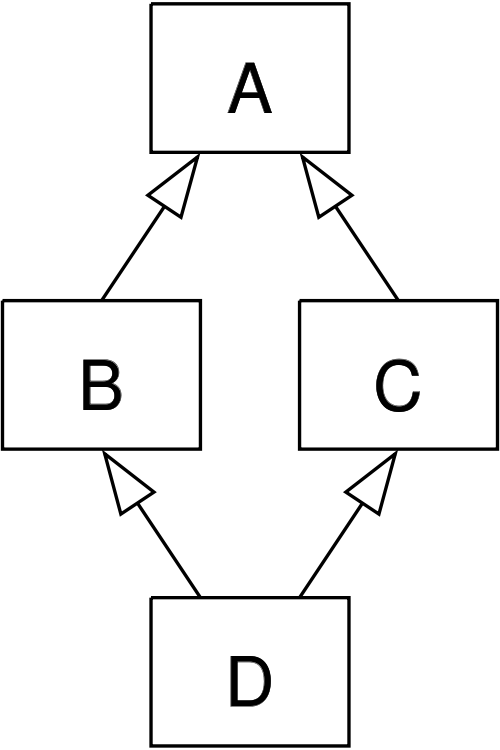Multiple Inheritance
Finally, we can also build classes that are able to inherit from multiple parent classes. In Java, this is done through the use of interfaces.
The Diamond Problem
Before we can really understand the importance of multiple inheritance, we must first discuss the “Diamond Problem.” This is a very common example in object-oriented programming, and it is used to describe one of the common pitfalls for multiple inheritance in programming.
Consider the following code, which defines 4 classes:
public abstract class A{
public abstract void do_something();
}
public class B extends A{
public void do_something(){
System.out.println("B");
}
}
public class C extends A{
public void do_something(){
System.out.println("C");
}
}
public class D extends B, C{
}In this code, we are trying to inherit from both class B and C inside of D. So, we’ll end up with a class hierarchy diagram that looks something like this:
The problem arises when we try to use the class D, as in this sample program:
public class Main{
public static void main(String[] args){
D obj = new D();
obj.do_something(); // what happens?
}
}In this example, we are calling the do_something() method on an object instantiated from class D. However, that method is defined in both B and C, which are parents of D. So, what version of the code should we use?
In short, we have no idea! That is the crux of the diamond problem: if we allow multiple inheritance, we can run into situations where the program has no idea which version of a function’s code to use.
Interfaces
Java allows us to solve this by the use of a special type of abstract class called an interface. An interface is an abstract class that only includes abstract methods, with no other data. One way to think about it is that it is simply describing the actions a class should be able to perform, also known as an interface.
So, we can update the example above a bit using interfaces instead of abstract classes.
public interface B{
public void do_something();
}
public interface C{
public void do_something();
}
public class D implements B, C{
public void do_something(){
System.out.println("D");
}
}Here, we have used the keyword interface to declare that classes B and C are interfaces, and will only include abstract method declarations. Then, we can use the implements keyword to show that our class D is implementing both of these interfaces. We can also extend D from another class, and that would be placed before the implements keyword.
Of course, by doing so, we have to provide the implementation for do_something() in D. But, we can store an instance of D in variables for storing both B and C data types. Pretty neat, right?
We won’t use multiple inheritance in this course, but it is helpful to know that it is available as we go forward in our programming experience.
-
File:Diamond inheritance.svg. (2018, September 25). Wikimedia Commons, the free media repository. Retrieved 02:42, November 4, 2019 from https://commons.wikimedia.org/w/index.php?title=File:Diamond_inheritance.svg&oldid=321823174. ↩︎
